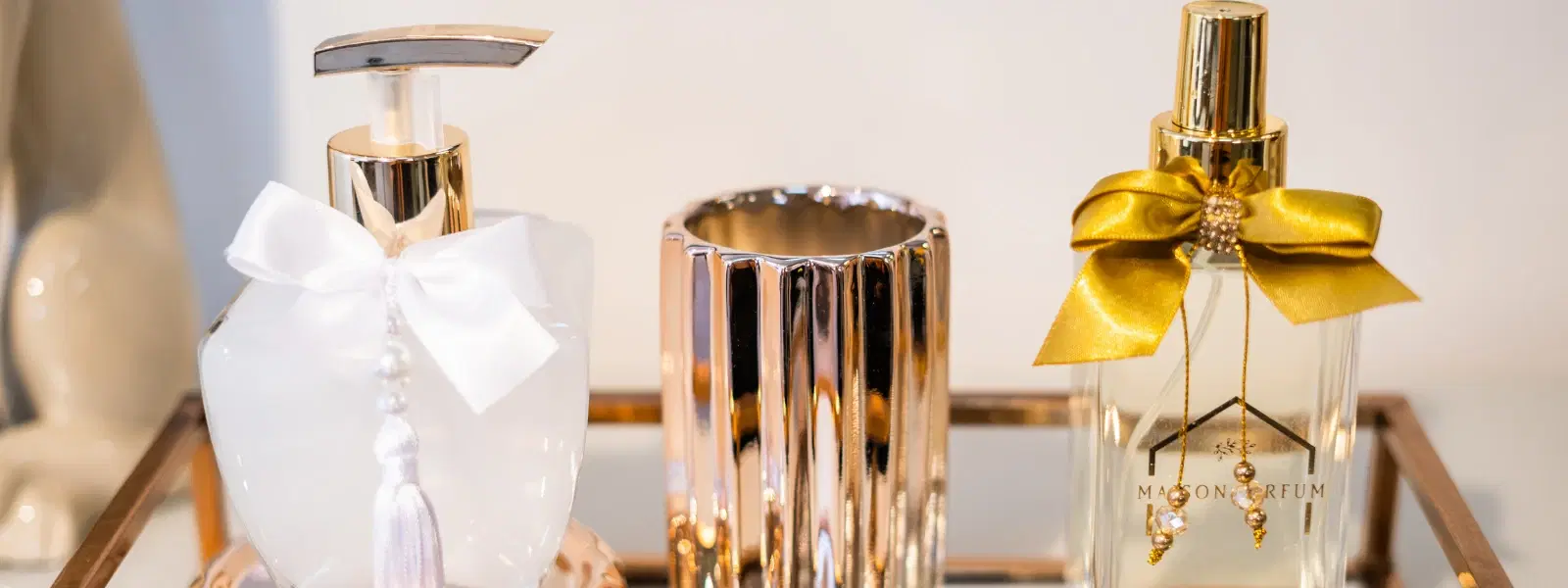
Luxury Edit
•05 min read

Perfume is more than just a fragrance—it is an art form where each note tells a story. In the world of luxury scent creation, every ingredient plays an important role. This blog post explores the differences between natural and synthetic perfume ingredients and dives deep into how each is used in high-end scent ingredients. Readers will gain insights into the rich tapestry of natural perfume elements and the innovative touch of lab-created molecules in luxury perfume formulations, helping them appreciate the allure behind every exclusive fragrance blend.
Every luxury fragrance is built on a carefully curated collection of perfume ingredients. These are generally divided into two categories: natural and synthetic components. Natural perfume elements are derived directly from nature—flowers, plants, and even animal sources. On the other hand, synthetic ingredients are produced in the lab to replicate or enhance natural scents. Both types bring unique benefits to the world of designer fragrance components.
Natural Perfume Elements: These include essential oils, absolutes, and resins. Methods like distillation and solvent extraction are commonly used to produce ingredients such as rose oil, sandalwood, and ambergris.
Synthetic Perfume Ingredients: Lab-engineered molecules like aldehydes, synthetic musks, and other compounds provide consistent and stable premium fragrance notes.
The choice of ingredients impacts not only the scent profile but also the longevity and ethical standpoints of a fragrance. High-end scent ingredients are carefully selected to ensure each perfume formulation stands out in complexity, quality, and desirability. Consumers are increasingly interested in understanding the blend behind their favorite scents, and this awareness helps drive the appreciation of both natural and synthetic artistry used in luxury perfume creations.
Pure natural ingredients have always been synonymous with sophistication. Many luxury fragrance components derive their charm from elements that are as rare as they are exquisite. Some of the most treasured natural perfume elements include:
Rose Absolute: Prized for its rich, deep floral aroma extracted from rose petals.
Oud: An exotic note coming from agarwood with a distinctive woody scent.
Ambergris: Known for its warm and musky profile, it adds complexity to any fragrance.
Sandalwood: Favored for its creamy yet earthy woody essence.
Natural ingredients bring a unique authenticity to perfume compositions. Many connoisseurs of luxury scent creation appreciate the evolving complexity that natural notes exhibit on the skin. The key advantages include the following:
Authenticity: Each natural ingredient offers an unreplicable signature that can only be found in nature.
Sustainability: Ethically sourced materials ensure that the beauty of nature is preserved along with its purity.
Dynamic Complexity: Natural notes add layers and depth; they can evolve and transform over time on the skin.
While natural perfume elements are celebrated for their originality and richness, they do come with certain challenges. For instance, rare perfume materials like oud or ambergris can be very expensive. Additionally, natural ingredients often vary in quality due to differences in seasons or environmental conditions. This variability can sometimes translate into subtle differences in scent, making each bottle of luxury perfume formulations uniquely personal.

The advancement in synthetic technology has redefined luxury fragrance components. Perfumers now have the flexibility to experiment with lab-created compounds that provide clear-cut advantages in consistency and innovation. Some popular synthetic ingredients include:
Aldehydes: Renowned for their crisp and sparkling profile, they add an unforgettable dimension to modern scents.
Iso E Super: This molecule is famous for its subtle yet velvety enhancement of other notes.
Synthetic Musks: Engineered to mimic the natural richness of animalic musks without ethical concerns, allowing designers to maintain responsible fragrance creation.
Synthetic components offer several compelling benefits. Their predictable nature ensures that every batch of fragrance has a consistent premium quality. Moreover, lab-created ingredients usually incur lower production costs, making them a practical choice for consistent luxury fragrance components. This blend of science and creativity opens up endless possibilities in luxury perfume formulations. Perfumers can design entirely new scents that merge art with innovation, giving birth to creative yet reliable antique trends that resonate with modern sensibilities.
One significant advantage of synthetic perfume ingredients is their impact on sustainability. By reducing the demand for animal-derived materials, synthetic molecules support a more responsible approach to luxury scent creation. These innovations also help minimize ecological impacts associated with harvesting rare natural elements, reinforcing the values of responsible fashion and craftsmanship.
The finest luxury perfume formulations leverage the strengths of both natural and synthetic ingredients. The art of designer fragrance components often lies in finding the right balance between authenticity and innovation. Perfumers use natural elements to add depth and individuality to their creations, while synthetic molecules ensure that the premium fragrance notes remain consistent and durable. In many cases, synthetic ingredients help to amplify and sustain the subtler tones of natural perfume elements, resulting in exclusive fragrance blends that are both dynamic and enduring.
Enhancing Natural Notes: Synthetic ingredients can serve as powerful enhancers, making natural scents more pronounced on the skin.
Creating Unique Profiles: The combination of both worlds allows for the creation of entirely new olfactory experiences that are hard to replicate.
Balancing Artistry and Consistency: Merging artisan perfume ingredients with innovative synthetic formulations offers both uniqueness and reliability in every luxurious spray.
Artisan perfumers have mastered the craft of balancing natural authenticity with synthetic ingenuity. By thoughtfully blending natural ingredients with synthetic high-end scent ingredients, they craft stories that resonate with individuality and class. This personalization is what makes every luxury perfume formulation a work of art. The rich heritage of natural elements intermingled with synthetic precision is a testament to the dynamic realm of luxury scent creation.
Pro Tip: Choosing Between Natural and Synthetic Scents
Did you know that natural ingredients tend to evolve uniquely on your skin, while synthetic notes offer consistent longevity? When selecting a luxury fragrance, consider how it aligns with your lifestyle and your preference for authenticity versus innovation.
-8704a161-e35d-4932-b982-017add6889b1.png&w=3840&q=75)
For those passionate about luxury perfume formulations, understanding what goes into a fragrance is empowering. Look for brands that emphasize transparency by providing full ingredient details. This transparency not only builds trust but also guides you toward responsibly sourced natural perfume elements. Additionally, innovative synthetic molecules can be a mark of creativity and stability, ensuring that the scent profile remains both unique and long-lasting.
Transparency: Brands should clearly disclose their perfume ingredients, aiding your decision-making process.
Sustainability: Ethical sourcing of natural ingredients is key for eco-conscious consumers.
Innovation: Cutting-edge synthetic components are vital for maintaining unique and durable premium fragrance notes.
While exploring the world of luxury scent creation, it is important to be aware of certain ingredients that might raise concerns. Some synthetic compounds, such as phthalates, have been linked to potential health risks and should be avoided. Additionally, many brands now replace animal-derived musks with responsible synthetic alternatives. Ensuring that the fragrance you choose is crafted using high-quality components can enhance both the longevity and safety of the scent you love.
Natural ingredients are harvested from plants, flowers, and animals, while synthetic ingredients are made in laboratories. Natural components provide authentic and evolving scents, whereas synthetics offer consistency and innovation.
Yes, synthetic ingredients are generally considered safe and undergo strict testing to ensure they meet quality standards.
Natural ingredients often require complex extraction methods and come from rare sources, which increases their cost.
Look for brands that are transparent about their ingredient lists, use ethically sourced materials, and are known for their craftsmanship in luxury scent creation.
Natural perfumes may evolve more on the skin but sometimes have shorter longevity compared to synthetic fragrances designed explicitly for extended wear.
Natural and synthetic perfume ingredients both offer unique advantages in the art of luxury fragrance creation. While natural perfume elements bring authenticity and evolving complexity to a scent, synthetic ingredients add innovation and consistency that help create one-of-a-kind, long-lasting fragrances. This balanced blend elevates high-end scent ingredients into exclusive fragrance blends that perfectly capture both the heritage of artisan craft and modern creativity. Understanding these nuances invites consumers to appreciate the meticulous artistry behind designer fragrance components and discover a world where every note is a celebration of self-expression and style.